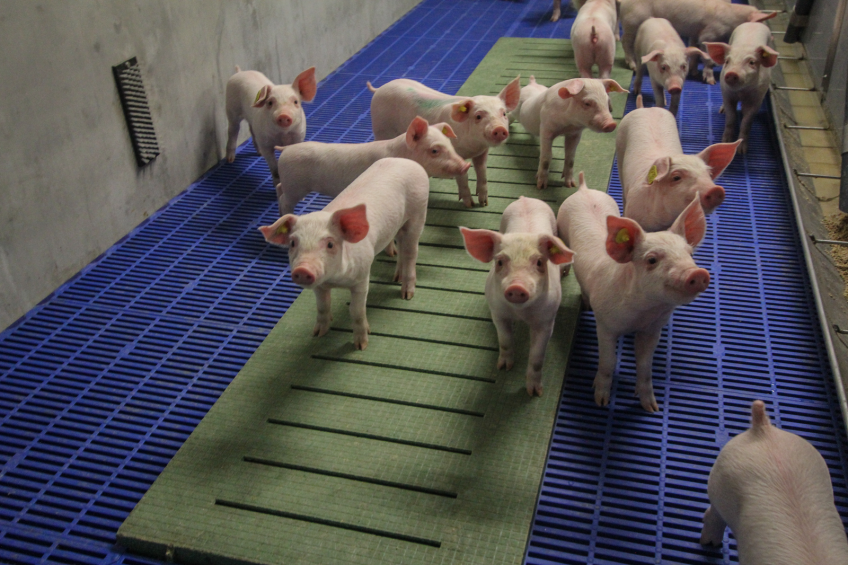Helping the gut mature by promoting enzymes

Many things change at the same time during weaning. Undeniably, the piglets’ gastro-intestinal system literally gets to digest a lot after weaning – whether it is ready or not. Solid State Fermentation can help the gut in this transition.
By Dr Jules Taylor-Pickard, Alltech
There are many ways to approach weaning. One can view weaning from the aspect of a new environment for the piglets; piglet stress due to separation from the sow or from the aspect of being exposed to pathogens from other litters.
Arguably the best approach to tackle weaning is through nutrition as a radical change of diet occurs. Nutrients, in sufficient quantity, are no longer received by the piglet from liquid milk alone and other sources such as solid feed are provided. Not every piglet reacts as easily to this change.
The difficulty can be partly ascribed to the fact that piglets are born with an underdeveloped gastro-intestinal system. It simply takes time for this and their own innate enzyme secretion system to fully develop, see Figure 1. Furthermore, the maturation process of both the gut and enzyme production can become disturbed during the weaning process. On top of that, during the post-weaning growth check, many pigs don’t eat or don’t eat enough – therefore if it is possible to maximise nutrient release from what they are eating it is possible to help the piglet handle the weaning transition.
Weaning is a complex event with many developments coinciding and influencing each other.
The bottom line is that inefficient enzyme secretion in piglets not only reduces their ability to digest and absorb key nutrients needed for growth, but can lead to undigested feed entering the lower gut, where pathogenic microbes can utilise these substrates for growth and colonisation, leading to a digestive disorder and diarrhoea.
Fermentation
Many farms try to address this problem by balancing out a starter feed formulation which contains the right mix of highly digestible and palatable ingredients which at the same time are affordable to producers. Enzymes usually play a role here, the question is which to utilise in this crucial phase of life?
Solid State Fermentation technology (SSF) is one option to encourage natural enzymes to enter the feed – a process which takes place long before the feed ingredients are being fed to piglets. Solid State Fermentation occurs in an environment that is carefully controlled for sterility, oxygen, pH, humidity and temperature.
Basically what happens is that a specially selected yeast strain is sprayed onto wheat bran and fermented in special environmentally-controlled fermentation chambers; a process which usually takes three to five days. As the fungus grows, it starts to digest the substrate and produces a wide range of different residual enzyme activities.
In effect, the SSF process results in an enzyme complex that is better able to break down the range of substrates found in feed. No structure stands alone, so for example the phytate molecule in wheat bran is linked to proteins, pectins etc. As a result, in order to release the phosphorus, xylanase and pectinase may be required before phytase can access the phytate properly – this is why greater benefits with SSF technology can be seen. Because all the enzymes have been produced together during the SSF process, they work in synergy resulting in a greater nutrient release than with individual enzymes or cocktails of different enzymes. More nutrients released from the diet means for example, that more energy is released which can be used by the gastro-intestinal cells. As digestibility is getting better, improvements in intestinal viscosity (very important in poultry and young animals) can be seen, as well as bacterial (pathogen) load. Improved viscosity and reduced pathogen load are obviously beneficial for the intestine, especially around weaning when piglets are more susceptible to disease and impaired gut structure.
Approaches
Alltech produces and distributes solutions based on this principle, namely Synergen. It is also possible to grow the Aspergillus niger on different substrates to produce a different residual enzyme capability. For example there is an SSF-DDGS – its grown on DDGS resulting in a residual enzyme capability that’s specifically suited for DDGS – resulting in a greater nutrient release, for example from one grown on wheat bran – as the residual enzymes produced are specific to the substrate.
Many trials have been conducted on the efficacy of enzymes in starter pig diets. In general, these are combined enzymes, which should be used according to the major feed substrates. Residual enzymes produced via SSF are specific to the target feed materials, and are highly specific to the feed type used in young pig diets. Commercial feed enzymes are either used on an ‘on top’ system, whereby the digestion of key nutrients are enhanced throughout, or by ‘down-specification’, where the additional increase in digestion is accounted for in the formulation, thereby maintaining current performance levels at a reduced cost.
Recent trials conducted in France in 2011 with starter pigs compared the performance of a positive control diet and a negative (down-specified in energy and lysine) diet supplemented with an SSF-manufactured product at 200 g/t. The basal diet was formulated using wheat, barley, maize, soybean meal and wheat by-products. The results are shown in Table 1. The data showed that the starter pigs that received the SSF-manufactured product performed well, matching the ADG of the positive control group.
Zootechnical elements
Piglet health is strongly dictated by the development of an adequate immune system as well as suitably efficient digestion of feed. In order to promote both of these aspects, specialist ingredients can be applied not only in piglet creep and starter feeds, but also to the dam during gestation.
This will ensure that piglets thrive better at birth, during weaning, when their naive immune and digestive systems must be robust enough to cope with the transition from the milk-based diets, and in their subsequent growth and productive performance until slaughter.
Other strategies to help mature the gut
Piglet immunity at birth is dictated by the immunoglobulins they receive in colostrum from the sow. Bio-Mos (Alltech) is a product made of bioactive fractions derived from the outer cell wall of a specific strain of yeast, Saccharomyces cerevisiae. It is well known to have an impact on the correct development and responses of the immune system, including expression in colostrum. This has been shown to lead to improved piglet immunity at birth and better piglet performance throughout the lactation and the post-weaning period.
In addition, at birth, the piglet gut is at risk of pathogenic colonisation, damage from bacterial toxins and lacks the enzyme secretion needed for efficient digestion. Nucleotides are used to promote gut development in infant animals and humans, and are involved with intestinal cell proliferation as well as repair of the gut lining. Creep and starter diets for piglets have been supplemented with products such as the commercial nucleotide and protein source NuPro.
References available on request.
[Source: Pig Progress special – Piglet Health, 2014]











